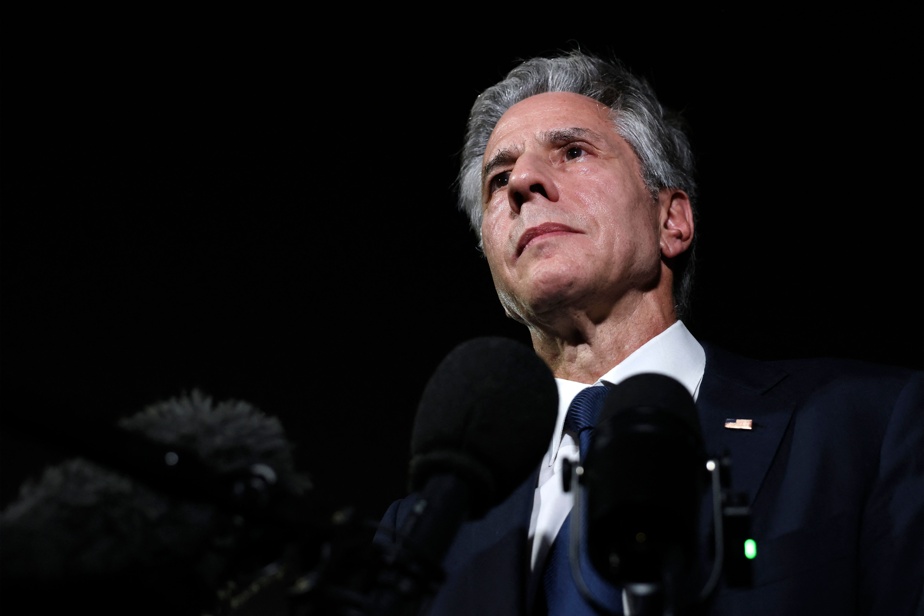(Doha) US Secretary of State Antony Blinken on Tuesday urged Hamas to accept the latest US truce proposal for the Gaza Strip, but also expressed differences with Israel, concluding a new round of shuttle diplomacy in the region.
Mr Blinken, who was making his ninth trip to the Middle East since the deadly Hamas attack on October 7, warned that the truce proposal could be the “last chance” to end the conflict.
“Time is running out” after more than ten months of war, he stressed after visiting Qatar and Egypt, two key Arab mediating countries, and Israel.
Triggered by an attack by the Palestinian Islamist movement on Israeli soil, the war in Gaza is continuing unabated. An Israeli strike on Tuesday on a school sheltering displaced people in Gaza (north) killed at least 12 Palestinians, including children, according to the local Civil Defense. The Israeli army says it targeted “terrorists hiding” in the school.
Israel and Hamas have accused each other of blocking a deal, amid international concerns about the spread of war in the region.
“Every day that passes risks bringing more misery to good people who do not deserve it,” Antony Blinken told reporters before leaving Doha, the capital of Qatar, where he met with Minister of State Mohammed bin Abdulaziz al-Khoulaifi.
“It has to happen, and it has to happen in the coming days. And we will do everything possible to get it across the finish line,” he said of the truce proposal.
On Friday, Washington submitted a compromise proposal for a truce to negotiations in Doha between Israel and the mediators, and further talks are expected in Egypt this week.
Mr. Blinken said Monday that Israeli Prime Minister Benjamin Netanyahu had “accepted” the plan and called on Hamas to “do the same.” He reiterated that demand Tuesday.
But Israeli Prime Minister Benjamin Netanyahu insists that Israel retain control of the Philadelphia Corridor, a narrow strip of land along the Gaza-Egypt border, according to Israeli media.
“Not constructive” statements
From the beginning, it has been “very clear that the United States does not accept a long-term Israeli occupation of Gaza,” Blinken said when asked about Netanyahu’s reported comments. He said Israel had already agreed to the “locations and timing of the withdrawals” of troops.
Speaking on condition of anonymity, a senior U.S. official who accompanied Mr. Blinken was more direct, saying that such “maximalist statements” from Mr. Netanyahu were “not constructive” in reaching a truce.

PHOTO REUTERS TV, REUTERS
Smoke and flames rise after an Israeli strike on a hotel in Gaza City, in this screenshot taken from video, August 20, 2024.
Mr. Blinken acknowledged that differences remained and called on Israel and Hamas to show “maximum flexibility.”
Egypt, the first Arab country to make peace with Israel, was angered by the Israeli military’s takeover of the border in May.
Hamas said it was “desirous of reaching a ceasefire” but protested against the “new conditions” set by Israel in the latest American proposal.
The Palestinian movement is demanding the implementation of a plan announced on May 31 by US President Joe Biden, and which he accepted in early July, providing for a six-week truce accompanied by an Israeli withdrawal from densely populated areas of Gaza and the release of hostages, then, in a second phase, a total Israeli withdrawal from the besieged territory.

PHOTO MOHAMMED SALEM, REUTERS
Palestinian students, gathered on the ruins of a house, use their mobile phones to study online due to the destruction and closure of schools and universities, amid the ongoing conflict between Israel and Hamas, in Khan Younis, southern Gaza Strip, August 20, 2024.
Mr Netanyahu has repeatedly said he wants to continue the war until the destruction of Hamas, which has been in power in Gaza since 2007 and is considered a terrorist group by Israel, the United States and the European Union.
A worsening toll
On October 7, Hamas commandos infiltrated from Gaza launched an attack that resulted in the deaths of 1,199 people on the Israeli side, mostly civilians, according to an AFP count based on official data.
Of the 251 people abducted that day, 105 are still being held in Gaza, including 34 declared dead by the army.
The Israeli retaliatory offensive has left at least 40,173 dead, according to the Hamas government’s health ministry, which does not provide details on the number of civilians and fighters killed. The UN says most of the dead are women and minors.

PHOTO MOHAMMED SALEM, REUTERS
Palestinians walk in an area damaged by the Israeli offensive, as part of the ongoing conflict between Israel and Hamas, in Khan Younis, southern Gaza Strip, August 20, 2024.
On Tuesday, the army announced that it had recovered the bodies of six Israeli hostages during an operation in a tunnel in Khan Younis (south). Five had been declared dead in recent months, the sixth was announced on Tuesday.
In the devastated Gaza Strip, where almost all of the 2.4 million inhabitants have been displaced, Israeli bombardments continue.
In addition to the strike on the school, six Palestinians were killed in Rafah (south), according to medical sources. Another medical source reported four deaths in Israeli fire on the east of Khan Younis.
Seven people were also killed in an Israeli bombing in Deir al-Balah (centre), the Civil Defense said.
For the United States, a ceasefire in Gaza should also help prevent a possible attack on Israel by Iran and its allies – Lebanese Hezbollah, Hamas and Yemen’s Houthi rebels.
The latter threatened to retaliate for the assassination, attributed to Israel, of Hamas leader Ismail Haniyeh in Tehran on July 31, and that of Hezbollah military leader Fouad Chokr, killed the day before in an Israeli strike near Beirut.
The Lebanese Health Ministry announced on Wednesday that Israeli strikes had left at least one person dead and 19 wounded in the east of the country, hours after four people were killed in other attacks in the south.
